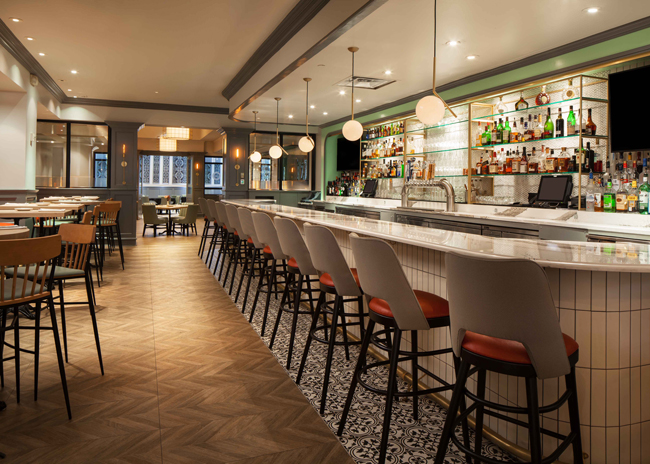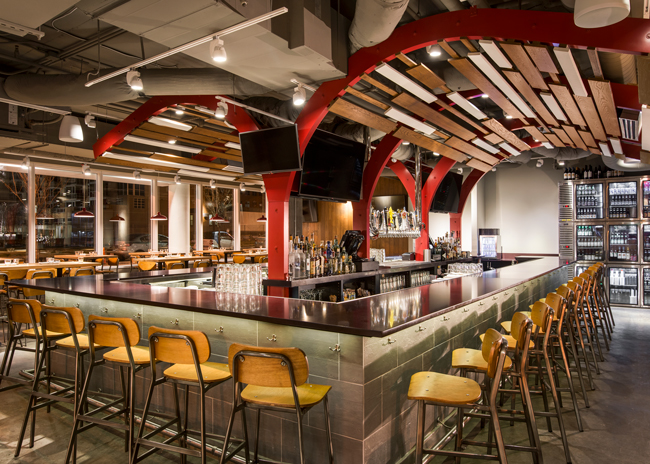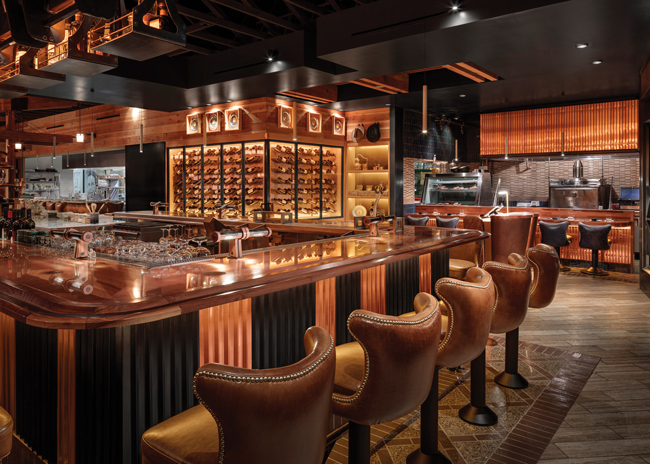Griz Dwight, Principal and Founder of GrizForm Design Architects, offers five best practices for designing a restaurant's bar.
Restaurant bars should always stand out. They’re social by nature and therefore play an important role in the social aspect of going out.
1. Make it stand out.
The easiest way to make a bar stand out is with the right lighting and height. A bar that stands out has a glow and sparkle aspect that catches your eye and draws you in. The use of different colors and contrasting finishes also helps a bar stand out.
Bars need to have a unique glow. While the dining area usually needs more lighting, there is generally less overhead lighting for bars. Instead, the lighting should come from different places, whether that be a back glow through the bottles or from under the bar.
I really like how our design came together for Legal Sea Bar in Union Station, also in D.C., because it’s so different from its surroundings. It really pops and draws people in because of the colors and patterns used. It’s also a horseshoe-shaped bar with a lot of activity to it. Image courtesy of Daily Grill
Image courtesy of Daily Grill
2. Design for practicalities.
Flow is the biggest mistake in bar design. You really want to make sure the drinks can get out of the bar and into the restaurant and that guests can get to the bar to order the drinks. Bars fail when there’s only a narrow entry, especially on busy nights when people clog the entry and block patron access to the bar. The best restaurant bars have drink pick-up on the back or quiet side so servers can get their drinks without disrupting the flow of the guests in the middle. A second common mistake I’ve seen in restaurant bars is a lack of storage for glassware. For example, if you’re a tequila bar, it’s important that the design of the bar allows for the proper display and service of the tequila.
The bar should foster a natural flow that allows patrons to be able to find their perfect spot, whether it be through making eye contact with their friends or simply by walking through the space to find an empty seat. One of my favorite bars is Salt Line in Washington, D.C. It has great flow. You can approach the bar from different sides, and the liquor can be seen from all sides; there are cool purse hooks, glow lighting and other elements that make it the activity hub of the restaurant.
It’s also important to make sure the guest side of the bar has the essential practicalities — coat hooks and power strips for patrons to charge their electronic devices, a foot rail or footstep. You don’t necessarily notice these things when they’re there, but you notice when they’re not.
 Image courtesy of Amber Frederiksen Photography
Image courtesy of Amber Frederiksen Photography
3. Be on trend but not trendy.
You want to be on trend but not trendy, and that’s a difficult thing to define. Trendy can be gimmicky, which can be cool for a moment, but bars need to have longevity. We try to do what’s right for each individual space and restaurant concept. For example, if it’s on trend to have a two-story bar and we only have a single-story space, we still have to figure out how to get that vibrancy from the bar area. It’s also important to keep up on the latest trends because designers need to set up the bar area to facilitate them. For example, we have one bar under construction where the client wanted to have a 600-pound block of ice made daily that bartenders will chip off for cocktails.

4. Factor in sightlines.
Sightlines are extremely important. In most instances, the bar is the activity center for the restaurant. People like to see and be seen. There are certain times of the night that the bar is really feeding energy to the restaurant and other times where the restaurant energy is feeding into the bar. Good sightlines are a must to keep that energy flowing.
A guest should be able to walk in one entrance and be greeted by a host stand, then make their decision on whether they want to go into the dining room or the other direction to the bar. The bar and dining area should merge together and feed off each other’s energy.
5. Use quality materials.
Choose your seating carefully. Is it a bar you’re going to have a meal at or one that will be churning over cocktails? The best practice for chair selection is that it’s sturdy. You’ll be paying twice for a low-budget barstool that isn’t built to withstand high usage. We always get a sample of the barstool before we put it in a restaurant, which has helped us avoid a lot of costly mistakes. The materials for the bar top are also important as they get more wear-and-tear and see spilled drinks and acid from lemons and limes. We’ve made mistakes in the past where materials haven’t weathered the way we intended, so we pay careful attention to that.




